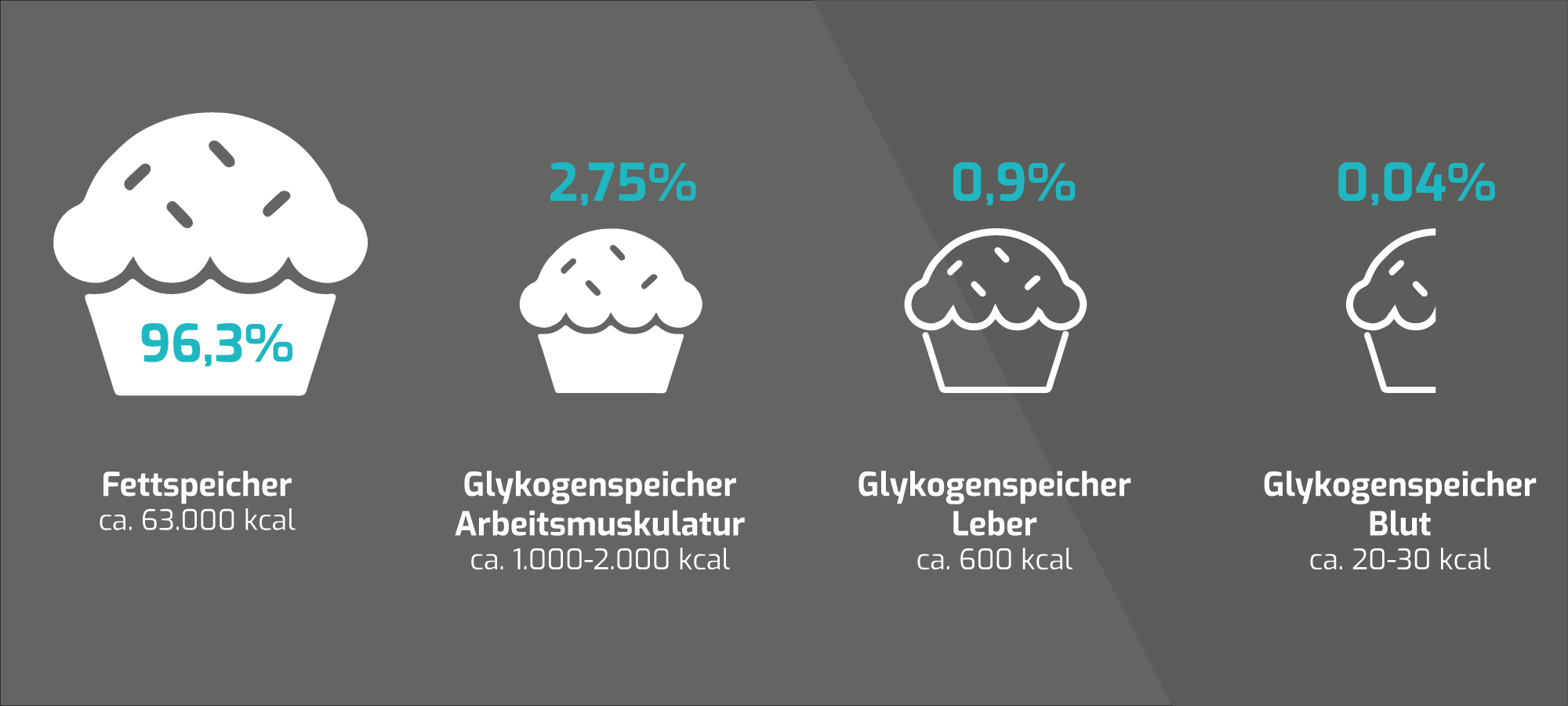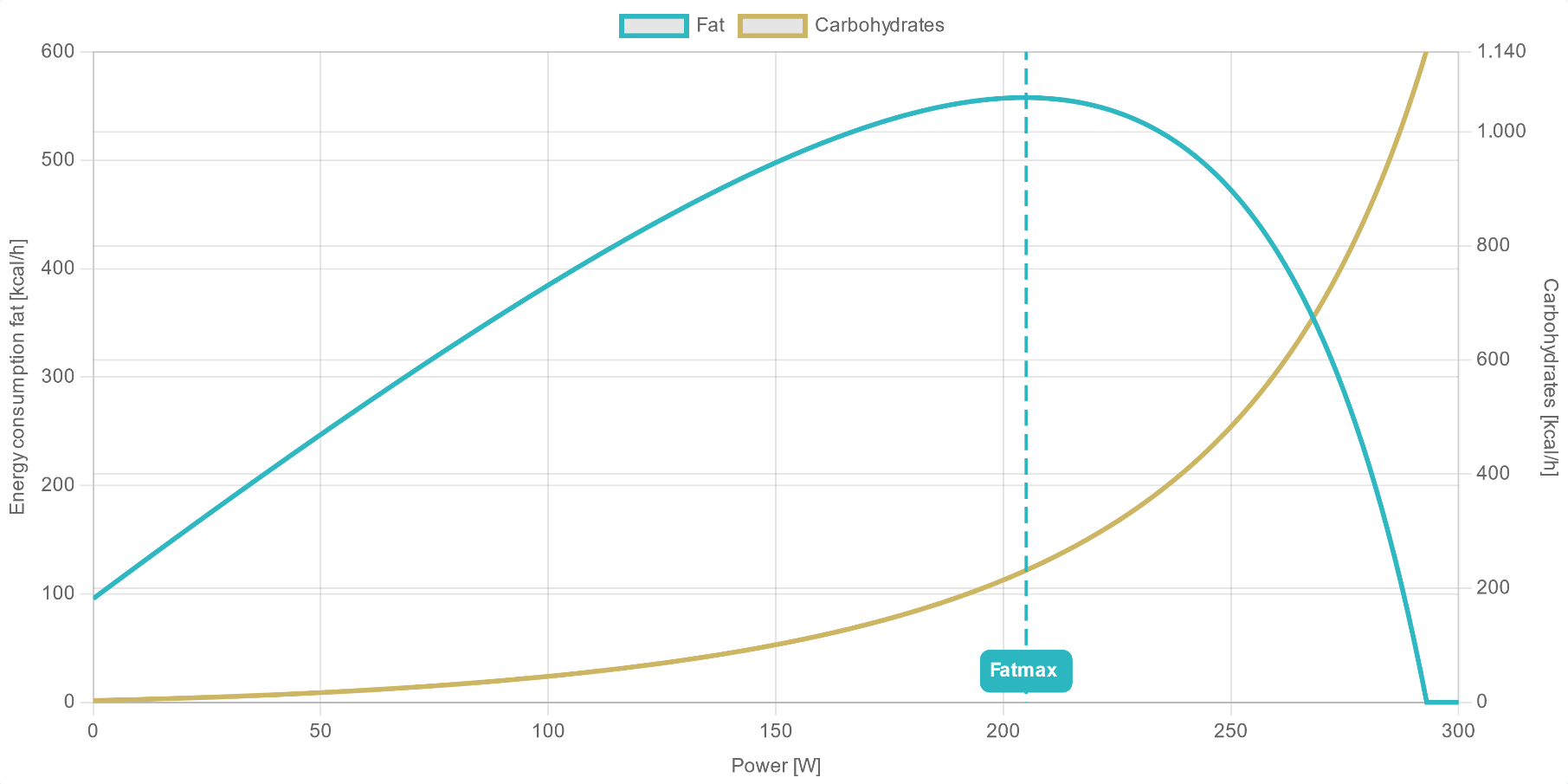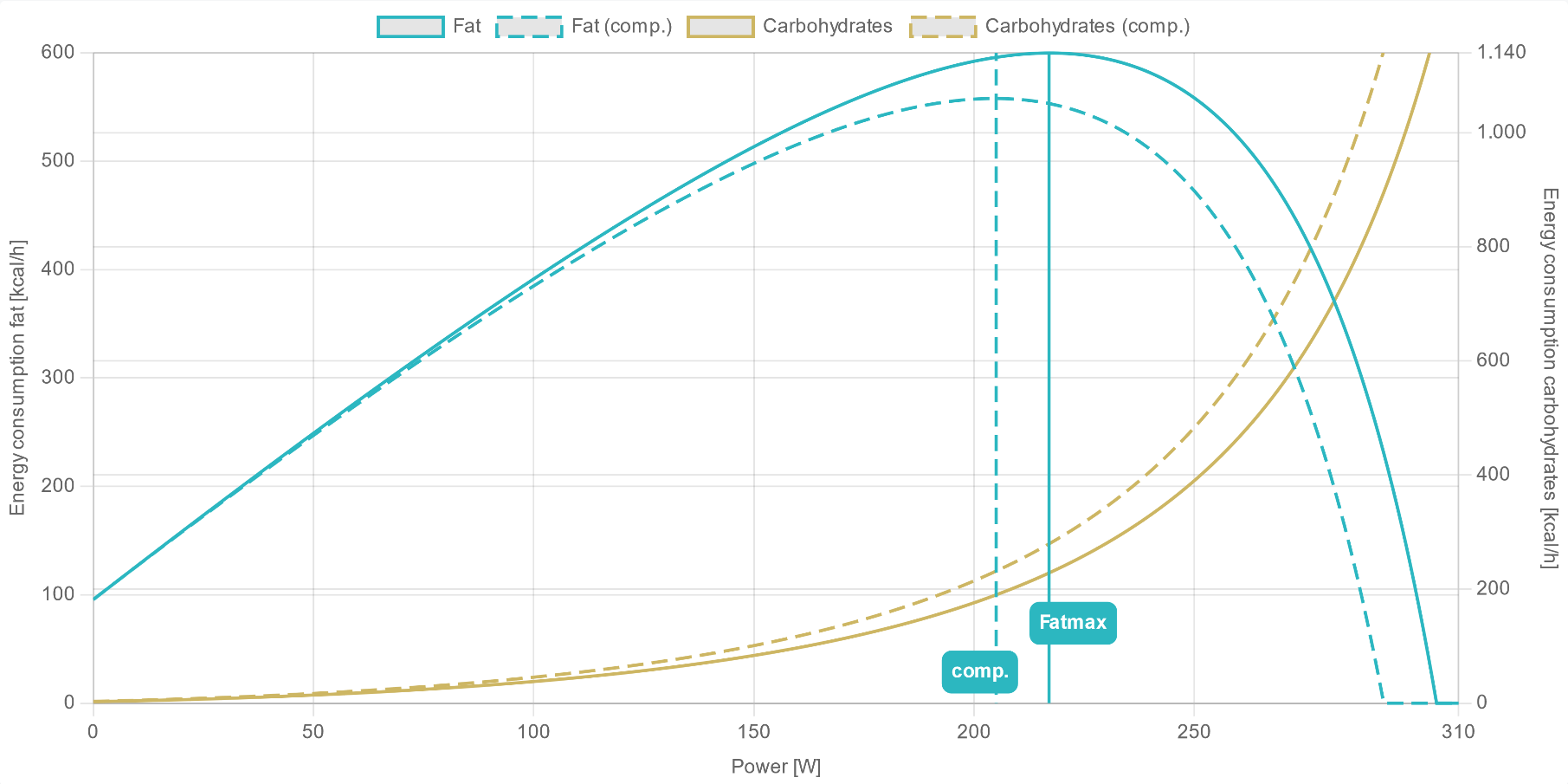Fatmax and Fat Metabolism
Fat Metabolism in Endurance Sports
Fat metabolism plays a crucial role in endurance sports and as a cyclist or triathlete, you’ll strive for an optimized fat metabolism. This means that during training and competition, fatty acids are primarily used for energy supply, and carbohydrates are spared as long as possible.
Since fatty acids are metabolized via the aerobic system (with oxygen), an endurance-optimized metabolism is characterized by a strong aerobic metabolism and a low proportion of anaerobic energy production (glycolysis). The reason is simple: fats are available indefinitely, whereas carbohydrate stores are limited. When glycogen stores are replenished, approximately 400 to 700 grams of carbohydrates can be stored in the muscles and another 100 to 150 grams in the liver. The exact storage size depends on the size of the active muscles and the fitness level.
In all endurance disciplines, carbohydrates are needed for race-deciding performances and it is important to conserve the carbohydrate stores in the working muscles (predominantly the lower limbs in cycling) for as long as possible.
A well-developed fat metabolism spares the glycogen stores for as long as possible and the amount of metabolized carbohydrates remains low.
Fat as an Energy Source
There are different types of fatty acids: saturated fatty acids, unsaturated fatty acids and trans-fats. Unlike short-chain carbohydrates, long-chain fatty acid molecules are broken down and metabolized aerobically with the help of oxygen.
The energy density of fatty acids is around 9 kcal per gram of fat. One kilogram of fat thus has an energy density of 9000 kcal. A 70-kilogram athlete with a body fat percentage of 10 percent still has 7 kilograms of fat and theoretically available energy stores of about 63,000 kilocalories. In order to use as much of this energy as possible and spare the precious carbohydrates, it is crucial to train the fat metabolism specifically.
Energy Storage of the Human Body

Example of a 70-kilogram athlete with 10 percent body fat
What Is Fatmax Training?
FAT = fats and max = maximum: Fatmax is defined as the intensity zone at which the fat metabolism works at its highest rate (in absolute terms). In other words, the power at which the most energy is derived from fatty acids. Fatmax is highly individual and dependent on aerobic and anaerobic metabolism. A well-developed fat metabolism means, that the limited carbohydrate stores are spared and fatigue sets in later.
By definition, Fatmax has been known in sports science for decades and is described by the maximum pyruvate deficit. At the point of maximum pyruvate deficit (which is formed in the muscles during glycolysis), the oxidative phosphorylation capacity of the mitochondria is at its highest and undergoes the highest possible fat metabolism.
Fat oxidation during exercise is always dependent on intensity and varies greatly from individual to individual. As can be seen in the graph, at low intensities, not much fat is burned as the overall energy expenditure is low. As intensity increases, fat oxidation increases until it reaches its maximum at Fatmax. A further increase in power above Fatmax leads to a decreased fat oxidation whereas carbohydrate expenditure increases exponentially. At high intensities above the anaerobic threshold, fats are no longer metabolized.
However, the Fatmax value says nothing about the carbohydrate expenditure at the same power output. Fats are never used exclusively for energy production and parts of the supplied energy always comes from glycolysis. As can be seen in the graph, even at Fatmax a relatively large amount of carbohydrates is combusted for energy production. In this example, it is 56 grams of carbohydrates per hour at a Fatmax of 205 watts.

Energy diagram of an exemplary AI DIAGNOSTICS performance report
Fatmax is mainly determined by the two "limiters" VLamax and VO2max. If a lot of energy is provided via the glycolytic system (high VLamax), relative fat metabolism will be lower. In contrast, if VLamax is low and aerobic metabolism is well developed, fewer carbohydrates are consumed and fat metabolism is increased.
Fatmax cannot be derived in a generalized approach from your anaerobic threshold. With AI DIAGNOSTICS you determine your individual Fatmax intensity.
The Fatmax Training Zone
The Fatmax training zone describes the training intensity at which fat metabolism is at its highest. AI DIAGNOSTICS determines the fat- and carbohydrate expenditure for all intensities below the anaerobic threshold. Eventually, above the anaerobic threshold, no more fats are metabolized.
AI DIAGNOSTICS determines the individual Fatmax training zone to effectively train fat metabolism. It is important to understand that during Fatmax training not only fats are burned, but fairly high amounts of carbohydrates as well. Therefore, even during longer Fatmax training sessions, carbohydrates should be consumed in the range of 20 to 50 grams per hour.
Where Is the Fatmax Training Zone?
Fat metabolism is very individual and can be somewhere in the range of 50 to 80 percent of the individual VO2max, depending on the fitness level. A general derivation from VO2max or anaerobic threshold is inaccurate and should be avoided.
As can be seen in the AI DIAGNOSTICS analysis, fat metabolism decreases between Fatmax and the anaerobic threshold. To cover an increased energy demand, carbohydrate expenditure increases exponentially and fatty acids are replaced more and more by carbohydrates as an energy source.
Fatmax metrics of an exemplary AI DIAGNOSTICS performance report
How to Determine Fatmax?
Fat metabolism can be determined with the help of indirect calorimetry under laboratory conditions. In addition, there are various metabolic models that can be used to calculate fat metabolism. For both methods, a laboratory diagnosis with spiroergometric measurement is required.
With AI DIAGNOSTICS the individual Fatmax can be determined easily and comfortably at home. The unique methodology of AI DIAGNOSTICS makes it possible to determine physiological parameters using an easy-to-perform remote test.
Training for an increased fat metabolism
There are different ways to optimize fat metabolism:
- Train the fat metabolism directly via specific training sessions.
- Adapt nutrition accordingly.
- Shift the physiological "limiters" such as the maximum oxygen uptake (VO2max) and maximum lactate production rate (VLamax) via training.
All training sessions to improve fat metabolism have two physiological goals - reducing VLamax and increasing VO2max.
The former goal is accompanied by a reduction in glycolytic rate and thus a reduction in carbohydrate metabolism. Since glycolysis is the dependent variable in substrate utilization, the consequence would be to increase the body's use of fat instead of carbohydrates. The second goal is to improve aerobic metabolism to improve the body's fat-burning capacity.

Energy comparison diagram of two exemplary AI DIAGNOSTICS performance reports
Tips to Train Fat Metabolism in Cycling and Triathlon
- high consistency and training frequency
- Avoid high intensities during long endurance rides, as the body uses more lactate as an energy source and less fat is burned via aerobic metabolism.
- long endurance training sessions
- low-carb training and carbohydrate periodization
- Fatmax intervals
- VO2max training to improve aerobic metabolism. Since fat oxidation can only take place aerobically, improving aerobic metabolism leads to improved fat metabolism.
- high-intensity training (HIT training) in the right training zones to improve VO2max
Low-Carb Training
The low-carb training method has become very popular in recent years. Since low-carb training also entails some risks if not performed correctly, there are a few points to watch out for. Glycogen stores that are excessively depleted reduce overall training quality and adaptation and should be avoided at all costs. A reduction in performance and a suppressed immune system can be the consequences.
Fat metabolism can be increased via a periodized approach of carbohydrate intake before and during training sessions. A reduced carbohydrate availability reduces the contribution of carbohydrates to the energy supply. The reason is simple: if carbohydrates are available in higher amounts, the body will use them. If carbohydrates are permanently available, it leads to a reduced fat metabolism. If the availability of carbohydrates is reduced on the other hand, the body has to adapt and fats are used more. The increased activation of fat metabolism-related enzymes leads to increased adaptations of mitochondrial biogenesis and an improvement in fat metabolism.
Tips to Optimize Low-Carb Training:
- should not be performed more than 1 to 2 times per week
- reduction of carbohydrate intake already a few hours before the training session
- Low-carb does not mean fasted! Calories should be provided in the form of fats and proteins before the training session. If the training takes place in the morning, 30 to 60 grams of carbohydrates should be consumed for breakfast.
- controlled intake of carbohydrates during the low-carb training session to avoid negative effects on training quality, hormonal balance, and the immune function
- To start, low-carb training should not be longer than 90 minutes.
- Intensity should be low in the E1-range. With proper planning, specific E2 and Fatmax intervals can be included.
- increased carbohydrate and protein intake immediately after training